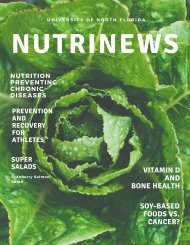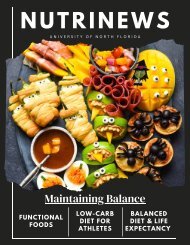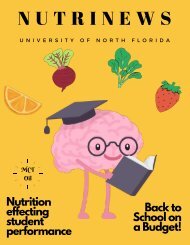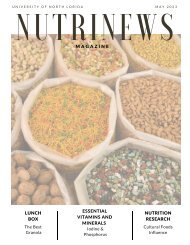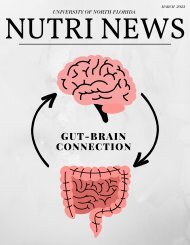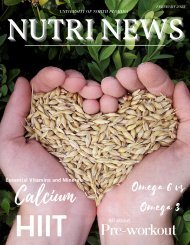February Issue 2024
This month the theme of our issue is Young at Heart. February is here and that means heart health month is too! In this issue of NutriNews we focus on nutrition and heart health. Lifestyle and nutrition play a significant role in our health, especially when it comes to the heart.
This month the theme of our issue is Young at Heart. February is here and that means heart health month is too! In this issue of NutriNews we focus on nutrition and heart health. Lifestyle and nutrition play a significant role in our health, especially when it comes to the heart.
Create successful ePaper yourself
Turn your PDF publications into a flip-book with our unique Google optimized e-Paper software.
SFAs only have single bonds, become<br />
solid at room temperature, and have<br />
short, long, or medium-chain fatty acids.<br />
Trans-fatty acids have more than one<br />
double bond in the trans configuration<br />
so while categorized as MUFAs, trans fat<br />
is structurally similar to SFAs. MUFAs have<br />
one double bond, become a liquid at<br />
room temperature, and have long-chain<br />
fatty acids. One main class of MUFAs is n-<br />
9 fatty acids. PUFAs have more than one<br />
double bond, become a liquid at room<br />
temperature, and have long-chain fatty<br />
acids. The main classes of PUFAs are n-3<br />
fatty acids and n-6 fatty acids. 1 In terms<br />
of food sources, SFAs are mainly found in<br />
animal fats such as milk, butter, cheese,<br />
and meats. 2 The majority of MUFAs and<br />
PUFAs are contained in plant and seed oils<br />
such as olive oil, canola oil, nuts, and<br />
avocados. 1 Trans fats primarily derive<br />
from partial hydrogenation of plant oils;<br />
however, a small proportion comes from<br />
ruminant animal products. 1<br />
Although carbohydrates and protein<br />
are the main fuel sources for athletes<br />
during high-intensity exercises, fat<br />
plays a crucial role in providing<br />
performance and health benefits. 3<br />
Athletes should consume mostly MUFAs<br />
and PUFAs due to their positive effects<br />
on the gut microbiome. Additionally,<br />
they are easier to utilize as a fuel source<br />
compared to SFAs and trans fats. 3<br />
There is inconsistent evidence on the<br />
effect of fat intake on gut bacteria and<br />
functions; however, studies show that<br />
fish oil and unsaturated fatty acid intake<br />
increased probiotics, Lactobacillus,<br />
and Bifidobacterium . 4<br />
In comparison, saturated fat reduces<br />
bacterial numbers and increases the<br />
excretion of short-chain fatty acids<br />
(SCFA). Athletes can utilize SCFA as a<br />
precursor for gluconeogenesis when<br />
energy demands are high. Furthermore,<br />
the effect of fat on gut bacteria<br />
depends on the type of fatty acid that<br />
reaps several benefits on exercise and<br />
overall health. For example, n-3 fatty<br />
acids are a type of PUFA found in fish,<br />
walnuts, and seeds. Studies show that<br />
n-3 fatty acids support brain health,<br />
lower blood pressure, aid in postexercise<br />
muscle recovery, reduce<br />
inflammation, and increase endurance<br />
ability. 4<br />
25






